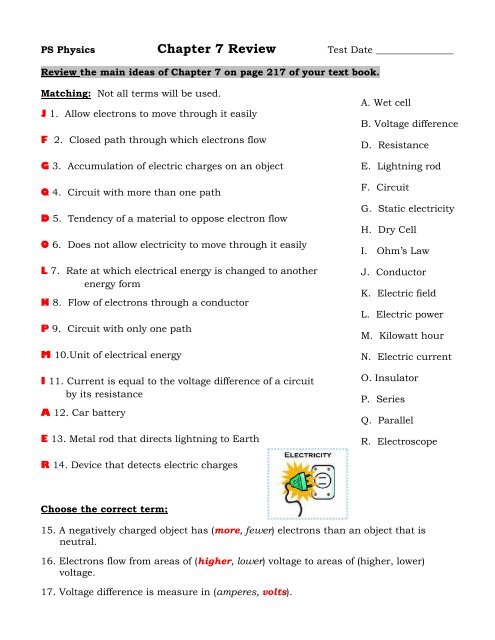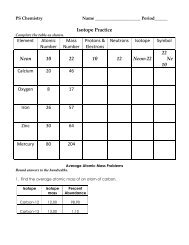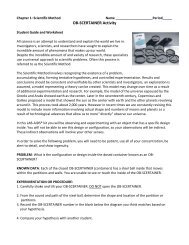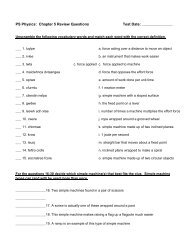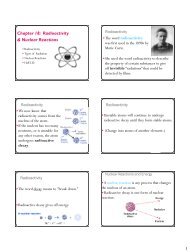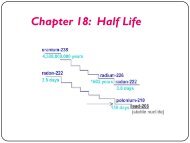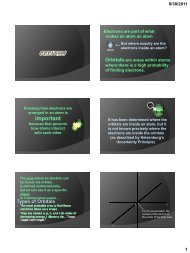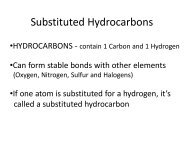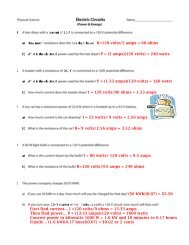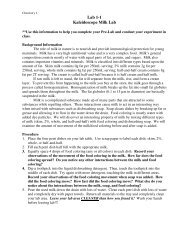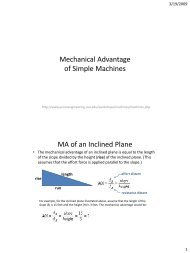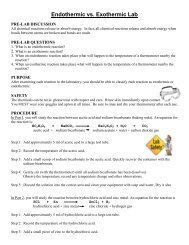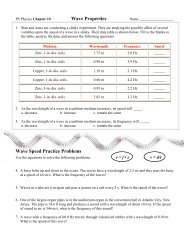Chapter 7 Review
Chapter 7 Review
Chapter 7 Review
You also want an ePaper? Increase the reach of your titles
YUMPU automatically turns print PDFs into web optimized ePapers that Google loves.
PS Physics <strong>Chapter</strong> 7 <strong>Review</strong> Test Date ________________<br />
<strong>Review</strong> the main ideas of <strong>Chapter</strong> 7 on page 217 of your text book.<br />
Matching: Not all terms will be used.<br />
J 1. Allow electrons to move through it easily<br />
F 2. Closed path through which electrons flow<br />
G 3. Accumulation of electric charges on an object<br />
Q 4. Circuit with more than one path<br />
D 5. Tendency of a material to oppose electron flow<br />
O 6. Does not allow electricity to move through it easily<br />
L 7. Rate at which electrical energy is changed to another<br />
energy form<br />
N 8. Flow of electrons through a conductor<br />
P 9. Circuit with only one path<br />
M 10.Unit of electrical energy<br />
I 11. Current is equal to the voltage difference of a circuit<br />
by its resistance<br />
A 12. Car battery<br />
E 13. Metal rod that directs lightning to Earth<br />
A. Wet cell<br />
B. Voltage difference<br />
D. Resistance<br />
E. Lightning rod<br />
F. Circuit<br />
G. Static electricity<br />
H. Dry Cell<br />
I. Ohm’s Law<br />
J. Conductor<br />
K. Electric field<br />
L. Electric power<br />
M. Kilowatt hour<br />
N. Electric current<br />
O. Insulator<br />
P. Series<br />
Q. Parallel<br />
R. Electroscope<br />
R 14. Device that detects electric charges<br />
Choose the correct term;<br />
15. A negatively charged object has (more, fewer) electrons than an object that is<br />
neutral.<br />
16. Electrons flow from areas of (higher, lower) voltage to areas of (higher, lower)<br />
voltage.<br />
17. Voltage difference is measure in (amperes, volts).
18. Electrons passing through a lamp (gain, lose) some voltage as they light the lamp.<br />
19. Voltage (varies, is the same) in all parts of a series circuit.<br />
20. The current in a circuit is measure in (volts, amperes).<br />
21. Current is almost always the flow of (electrons, protons).<br />
22. Resistance is measured in (ohms, volts).<br />
23. Copper has a (higher, lower) resistance to electron flow than plastic.<br />
24. According to Ohms’ law, (I =V/R, V =I/R).<br />
25. The symbol for ohm is (Ω, O)<br />
26. A wire with a resistance of 3 ohms has a (greater, lesser) resistance to electron<br />
flow than a wire with a resistance of 5 ohms.<br />
27. Current has only one loop to flow through in a (parallel, series) circuit.<br />
28. A power rating lists the (voltage, watts) required to operate an appliance.<br />
29. A dry cell is used in a flashlight to convert (electrical energy, static electricity).<br />
30. Two positive charge will (repel, attract) one another.<br />
Multiple Choice:<br />
C 31. Electric charge that has accumulated on an object is referred to as<br />
A. Current electricity B. Circuit electricity<br />
C. Static electricity D. Current circuit<br />
B 32. A static discharge differs from an electric current in that a static discharge<br />
A. is a flow of electrons<br />
B. Lasts for only a fraction of a second<br />
C. Results because a force is exerted on the electrons<br />
D. Involves the movement of ions as well as electrons<br />
B 33. The rate at which an electrical device converts energy from one form to<br />
another is called<br />
A. Electrical energy B. Electrical power<br />
C. Electrical resistance D. Voltage regulation<br />
A 34. Lightning is<br />
A. a very large discharge of static electricity<br />
B. a buildup of neutrons<br />
C. low voltage electric current<br />
D. Harmless
C 35. One source of constant electric current is a ___.<br />
A. Switch B. Transformer C. Dry cell D. Coulomb<br />
B 36. The current in a circuit can be<br />
A. increased by increasing the resistance.<br />
B. increased by increasing the voltage.<br />
C. decreased by decreasing the resistance.<br />
D. decreased by increasing the voltage.<br />
B 37. Which of the following causes the leaves of an electroscope to spread apart?<br />
A. opposite charges on each leaf<br />
B. like charges on each leaf<br />
C. no charge on either leaf<br />
D. Charge on one leaf, no charge on the other.<br />
B 38. What is the current flowing through this circuit?<br />
A. 1.25 amps B. 0.80 amps<br />
C. 30 amps D. 120 amps<br />
A 39. What is the power consumed by the light bulb in this circuit?<br />
A. 96 watts B. 1.25 watts C. 1.25 kW D. 96 kW<br />
C 40. Which of the following substances is an electrical conductor?<br />
A. glass B. paper C. gold D. rubber<br />
Matching:<br />
Match the words in the first column to the correct unit in the second column.<br />
D 41. potential difference<br />
A 42. resistance<br />
C 43. Electrical energy<br />
B 44. current<br />
E 45. power<br />
A. ohm<br />
B. ampere<br />
C. kWh<br />
D. volt<br />
E. watt<br />
Short Answer Essay:<br />
What are the three components that make up a circuit?<br />
Current, voltage, resistance<br />
Compare series and parallel circuits.<br />
Components connected in series are connected along a single path, so the same current flows through all of the<br />
components. Components connected in parallel are connected so the same voltage is applied to each component.<br />
In a series circuit, every device must function for the circuit to be complete and in parallel circuits, each light has<br />
its own circuit, so all but one light could be burned out, and the last one will still function.
Practice Problems:<br />
What is the current of a circuit that has 3 V and 0.5 ohm of resistance?<br />
I = 3 volts/0.5 ohms = 6 amps<br />
What is the voltage if current is 0.5 A and resistance is 0.8 ohm?<br />
V = (0.5 amps)(0.8 ohms)<br />
= 0.4 volts<br />
What is the resistance if voltage is 3.0 V and current is 1.5 A?<br />
R = 3 volts/ 1.5 amps<br />
= 2 ohms<br />
A 60 watt car spotlight is showing a drain of 5.5 amps on the ammeter. What is the<br />
voltage?<br />
V = 60 watts / 5.5 amps = 10.9 volts<br />
My laptop uses 50 watts and I use it on average 8 hours a day. If the electric company<br />
charges $0.07 per kWh, how much does it cost to use my laptop for the school week (5<br />
days)?<br />
P = (0.5 kWatts)(8 hours)(5 days)($0.07)<br />
= $0.14 or 14 cents<br />
The load across a 50 volt battery consists of a series combination of two lamps with<br />
resistances of 125 Ω and 225 Ω.<br />
Find the total resistance of the circuit. R = 125 + 225 = 350 ohms<br />
Find the current in the circuit. I = 50 volts/350 ohms = 0.14 amps<br />
Find the voltage drop across each lamp.<br />
V = (0.14 amps(125 ohms)<br />
V = 17.86 volts<br />
V = (0.14 amps)(225 ohms)<br />
V = 32.14 volts<br />
Two resistances, one 6 Ω and the other 8 Ω, are connected in parallel. The resistors<br />
are then connected to a 12 volt battery.<br />
What is the current through each resistor? I=12 v/6 Ω I=12 v/8 Ω<br />
I= 2 amps I = 1.5 amps<br />
What is the total current in the circuit? ? I= 2 A + 1.5 A =3.5 amps<br />
What is the equivalent resistance of the parallel combination?<br />
R = 12 volts/3.5 amps = 3.43 ohms


